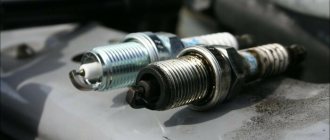- December 23, 2020
- Cars
- Nadezhda Zorina
"Niva-2121" is one of the most famous Soviet and Russian SUVs. This car first appeared in the second half of the 20th century. "Niva-2121" is still being produced. But new models of this SUV are already available with injection engines. Models with carburetor engines can also be found now, but only on the secondary market.
Quite often, many motorists wonder which Niva-2121 is better - with an injector or a carburetor? So, with the Niva injector it is more reliable.
Features of a carburetor car
Before deciding on the choice of a carburetor or injection Niva, it is very important to familiarize yourself with the technical characteristics of both SUV models.
The very first Niva-2121 engine was taken from the Zhiguli. In both the first and second cars, the engine had a large combustion chamber volume, that is, its working volume was 1580 cubic centimeters. Thanks to this engine, it was possible to develop power up to 80 horsepower. And the car could accelerate to 100 km/h in just 20 seconds.
Many novice motorists quite often ask specialists: what is the fuel consumption of the Niva-2121? The carburetor installed on the car affects the difference in fuel consumption compared to a car with an injection engine. Let's consider this nuance in more detail.
For example, judging by the technical data sheet of the car, then 13 liters is the fuel consumption of the Niva-2121. The carburetor, or rather its presence, greatly influences this indicator.
Over time, the engine became more and more modernized. And such an engine began to be numbered 21213. The working volume of the new engine became 1690 cm3, while the power of the power unit amounted to 83 horsepower.
Thanks to the new engine, the car has become more playful. It now takes 18 seconds to accelerate to 100 km/h. It is worth noting that with the introduction of the new engine, fuel consumption has decreased significantly: in contrast to the fuel consumption of the Niva-2121 with a carburetor (1.6 l), it has become less.
For example, if you look at the technical data sheet of an SUV, you will see that the manufacturer claims 11 liters. And as car owners themselves note, this figure is 13 liters.
In winter, the fuel consumption of the Niva-2121 with a carburetor is higher, since at this time it is necessary to warm up the car quite often and for a long time.
Chevy Niva gas tank capacity. what is the volume of the fuel tank in Chevrolet Niva
Home — Double-circuit gas boilers — About the Chevrolet Niva gas tank. What is the volume of the tank in a Chevrolet Niva? About the gas tank of a Chevrolet Niva. What is the volume of the tank in a Chevrolet Niva? It is difficult to imagine a vehicle that does not have a container for storing fuel liquid, through which the internal combustion engine is powered.
Let's consider what this container is, its main parameters, volume and some subtleties of the design. What is a ventilation system and how does pressure affect the gas tank. How to replace the gas tank on a Niva Chevrolet. This is what the removed Shnivy gas tank looks like. So, the main purpose of the gas tank is to store fuel, which is consumed directly by the vehicle for movement.
The Chevrolet Niva belongs to the class of SUVs, which means that its fuel consumption is quite high, and it also has all-wheel drive, which increases fuel consumption, so you should definitely pay attention to such a parameter as volume. Based on this, the manufacturer of the domestic car model considered this remark and the Chevrolet Niva is equipped with a gas tank with a volume of 58 liters. The actual capacity is larger - about 63 liters.
The gas tank of a Chevrolet Niva SUV is made of sheet steel, connected using welding seams. The steel structure of the tank has its pros and cons, so it’s worth highlighting them: The gas tank is located in the rear of the car under the seat.
Also interesting: Moving the generator to the top of 21214
This placement feature is not accidental, because according to statistics, emergency situations often lead to a head-on collision with the car. Neck, cap and lock of the gas tank The neck is a structure in the form of a steel tube into which fuel is poured.
The neck is connected to the gas tank by welding, and its second side is placed on the side of the Chevrolet Niva car. This is necessary in order to be able to conveniently refuel the vehicle. The neck is sealed using a special cap. The lid has a corresponding thread, through which it is fixed to the neck of the tank.
The standard equipment of a Chevrolet car is equipped with covers that do not have such a useful element as a lock.
The cap is quite easily removed from the neck, thereby opening access to the fuel, which is often used by villains. Thus, it is very important to protect yourself from unnecessary fuel costs and replace the standard cover with one that has a lock.
A lid with a lock is a fairly effective means of protecting the tank from draining gasoline. For this purpose, there are special models of lids with a lock that can be locked with a key. The lock in the lid design is strong enough and it is impossible to break it by applying physical force. Below in the photo you can see what a gas tank lock for a Chevrolet Niva is. When the key is turned, the thread is blocked, causing the cap to rotate idle on the neck.
When the key is turned back, the lock unlocks the latches, thereby making it possible to unscrew the tank cap. A lock built into the gas tank cap. Gas tank hatch. In the design of the gas tank, or more precisely, the body of a Chevrolet Niva car, there is such an element as a hatch.
Thanks to its presence, the tank neck is hidden, thereby not disturbing the design of the car's exterior. The hatch is called the outer cover, which is made mainly of sheet steel. The hatch is attached to the body structure using curtains, which ensure smooth opening and automatic slamming of the lid. The gas tank flap is a weak point, as the curtains of the structure periodically fail.
In some cases, repairs can be done, but this will require removing the hatch. But in most situations, a new device is purchased by choosing the appropriate color. The hatch is removed in the following sequence: Initially, the hatch itself opens directly; Using a Phillips screwdriver, you need to unscrew the two screws that hold the cover structure in place; Remove the product; Repair or replacement is carried out, after which the procedure for installing the cover is the reverse of removal.
To improve operation, the hatch must be lubricated with WD. Pressure and gas tank valve or ventilation system It is known that gasoline is a secondary petroleum product that tends to evaporate. But since the gas tank is a closed structure, and it is opened quite infrequently, there is a risk of pressure developing inside the tank.
The tank is designed for low pressure, so if it increases, there is a risk of rupture. But in addition to this, not only excess pressure can arise in the tank, but also a vacuum, which can cause: To prevent this from happening or in order to reduce the pressure, there is a special adsorber valve in the tank.
This valve is a small plug through which excess gasoline vapor is released. This valve is located directly in the engine compartment and is installed in a separate fuel line circuit coming from the gas tank.
Also interesting: Removal and installation of generator Niva 2121, Niva 2131
Thus, when excess pressure occurs in the tank, the adsorber purge system is turned on. The accumulated vapors are passed through the adsorber filter and enter directly into the cylinder, where they are mixed with the main fuel mixture and burned. In addition to removing excess pressure, the adsorber valve is also a ventilation system. This system is necessary to avoid creating a vapor lock in the tank.
The gas tank ventilation system helps prevent problems with vapor accumulation in the tank. If, when you open the tank lid, you hear the characteristic sound of air in the tank, this means that there is pressure in the tank.
The ventilation system does not cope with its task due to the canister valve being clogged with small particles and a vapor lock has occurred.
In such a situation, in order to stabilize the pressure in the tank, it is necessary to remove the adsorber valve and clean it. The valve is removed in the following order: Now the product is purged and cleaned, after which the valve is installed in the reverse order of removal.
Features of an injection car
The Volzhsky plant completely switched to injection engines in 2005. These changes affected not only the Niva-2121 SUV, but also many other cars. The new engine received a new number - 21214. The volume of the new gasoline unit began to be 1690 cm3. As for its power, it remained the same, the same as the carburetor - 83 horsepower. The acceleration remained the same, nothing has changed.
The fuel consumption of the Niva-2121 with an injector decreased, in contrast to the carburetor engine, by about 1.5 liters. This is already a big advantage compared to previous Niva models.
As for the average fuel consumption of the Niva-2121 per 100 km, these figures look like this:
- If you drive exclusively on the highway, then 8.3 liters will be spent per 100 km.
- If you drive exclusively around the city, then per 100 km the fuel consumption will be 12 liters.
- And if you drive in mixed mode, 100 km will require 10 liters of gasoline.
These data were obtained under standardized conditions using special measuring equipment.
Today, Niva-2121 is produced with an engine whose index is now 21214-28. The volume of the working engine is now 1774 cm3. The power of the new engine is 92 horsepower. And the SUV began to accelerate a little faster; it could accelerate to 100 km per hour in just 17 seconds. At the same time, fuel consumption does not exceed 10 liters.
Chevrolet Niva
This model was a joint development of the Russian company AvtoVAZ and the American corporation General Motors. The car is considered domestic, but is produced under the foreign Chevrolet brand.
Cars under this name have been produced since 2002 and are a sought-after product on the Russian automobile market. All-wheel drive is provided as standard. On the Chevrolet Niva, the main engine is a four-cylinder 1.7-liter gasoline unit with a capacity of 80 horsepower. The transmission is mechanical, five-speed. Maximum speed – 140 km/h.
What is a carburetor
If we compare the carburetor Niva and the injection one, we can conclude that the first is more archaic and old. The carburetor is the main component in this system. That is, it is this mechanism that, during operation, mixes air with a portion of gasoline, thereby creating a flammable mixture. The system itself is a simple device. But, despite this, many car owners are not entirely happy with this engine, since quite often it let them down.
A carburetor engine contains: a float, jets, and needles. It is worth noting that all these mechanisms require regular cleaning and regulation.
Disadvantages of the carburetor
The main disadvantages include the following:
- This engine is unreliable. That is, almost every season it is necessary to service the carburetor and adjust it.
- Such a motor is highly dependent on air temperature. Mostly problems arise in winter with such an engine. For example, if you overfill the spark plugs, it will be impossible to start the car. To do this, you will have to unscrew them and dry them. In addition, in winter the float often gets stuck, this is due to condensation. In the summer, many Niva owners with a carburetor engine are faced with such a problem as an overheated fuel pump.
- Low productivity. To increase the engine's potential, it is necessary to spin the engine to high speeds.
- Very high fuel consumption.
It is worth noting that, despite the fact that this power system is quite simple and repairable, it requires special attention. Many car owners should prepare in advance for the fact that they will have to rebuild the carburetor several times every year.
Fuel consumption and temperature
A uniform and smooth driving style helps reduce gasoline consumption. It is not recommended to brake or accelerate the car sharply - the result will be the opposite. Some factors are present only in winter. Thanks to them, the average gasoline consumption on a VAZ 21214 can almost double.
Increased fuel costs are determined by air temperature. The lower the thermometer shows, the higher the gasoline consumption.
This is explained by the fact that the engine, seats, external windows and steering wheel, windshield and rear windows warm up. In addition to this, there are a number of other reasons:
- reduction in tire pressure, which occurs automatically due to low temperature. This entails a narrowing of the tire rubber, resulting in a drop in pressure;
- The condition of the road in winter plays a big role. If there is ice on the road, then when the car starts moving, the wheels are polished and gasoline consumption increases;
- bad weather conditions (snowfall, blizzard) force drivers to reduce their speed, which entails the same high fuel consumption.
What has changed with the arrival of the new engine?
Today, Niva-2121 is produced only with injection engines. New engines began to use distributor injection, with each cylinder having its own injector. If previously all engine elements were mechanical, now they have become electronic. An electronic control unit also appeared in the SUV.
In order for the injection engine to always operate stably, it is necessary that there are sensors for monitoring air, detonation, and throttle position. This device also includes a crankshaft position sensor.
Although the system may seem very complicated, in reality it is not at all like that. The mechanical part of the motor has not become more complicated. In the injection model, instead of a carburetor, injectors and a fuel rail appeared, and as for the throttle valve, it is now located separately. Electronic sensors appeared.
Main advantages of the injector
The advantages of the injection Niva include the following:
- High with an injection engine is much faster compared to previous models.
- The operation of the internal combustion engine is stable. That is, due to the fact that the engine has IAC, many car owners have forgotten what floating speed is. Models with a carburetor engine always have real problems with this.
- Low fuel consumption of the Niva VAZ-2121. With the advent of the injection engine, the car began to consume about 20% less fuel.
- This engine is the most reliable. That is, such a motor does not need regular tuning, cleaning, or replacing jets. The only thing that the owner of a Niva-2121 car may need to do is clean the throttle valve. But this procedure is not mandatory. Experts recommend doing this in situations where the car picks up high speed at idle.
How to reduce fuel consumption
Gasoline consumption on a Niva 21213 carburetor can be reduced. First of all, it is advisable to check the condition of the carburetor. If it is clogged, it will immediately affect the fuel indicator. The same effect will occur when the compression in the engine is reduced. It is worth paying attention to the condition of the fuel system and regularly cleaning the jets and changing spark plugs. Monitor the functionality of the electrical system and wires.
An important component in fuel consumption is the quality of the fuel itself. It is better to refuel your car at proven gas stations from reputable dealers. Otherwise, fuel filters will fail faster, requiring replacement and costly repairs.
Injector disadvantages
As for the disadvantages, such an engine does not have many of them.
Due to the fact that a lot of electronics have appeared in the engine system, car owners may encounter malfunction of control sensors.
In situations where the SUV begins to consume a large amount of fuel, it is definitely recommended to recheck the mass air flow sensor. And if the engine no longer maintains normal speed at idle, then the IAC may be to blame.
And if the engine refuses to start, then it is quite possible that the contact has come loose from the crankshaft position sensor.
It is worth noting that although such problems do occur, they do not happen that often.
You can diagnose these problems yourself, using the simplest multimeter. To do this, it is enough to measure either the resistance or the contact voltage of any of the sensors.
From this we can conclude that breakdowns in most cases occur due to malfunctions of the electronics. As for the mechanical part, it does not raise any questions.
Niva gas costs, difference
Propane consumption, savings
| Volume | Transfers | Gas type | Gas consumption by road type | Refueling for 1000 km, mixed mode | ||||
| In the city | On the road | Mixed | Petrol | Gas | Difference | |||
| 1.7 | Mechanics | CIS | 15.4 | 8.8 | 11.0 | 3 742 ₽ | 2 047 ₽ | |
| LPG - liquefied petroleum gas (propane). Gas price in rubles per liter: CIS - 18.61 rubles. | ||||||||
Compressed natural gas is consumed in city mode at the speed of gasoline, and on the highway it is 20% slower. CNG is cheaper than LPG by one and a half to two rubles per liter.











